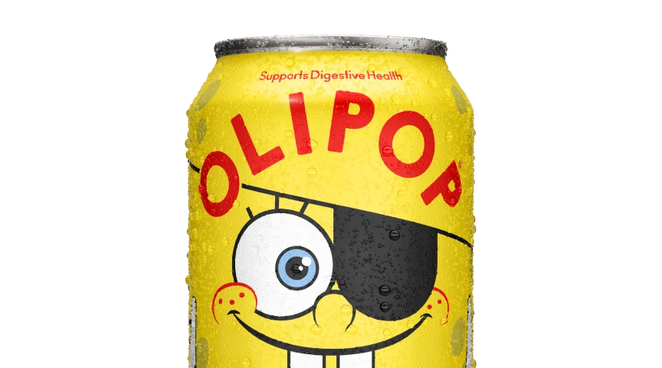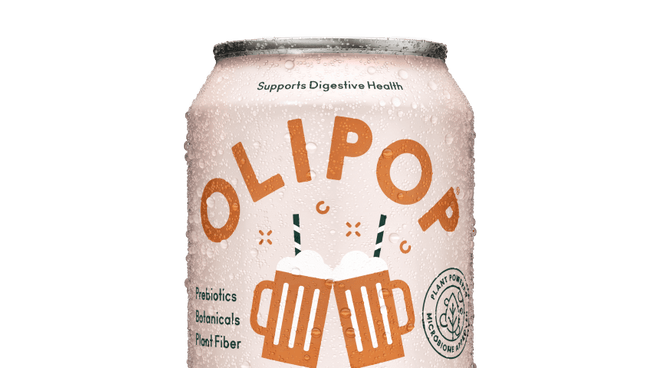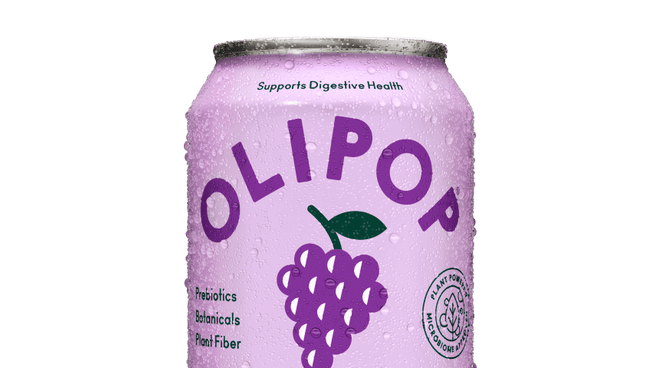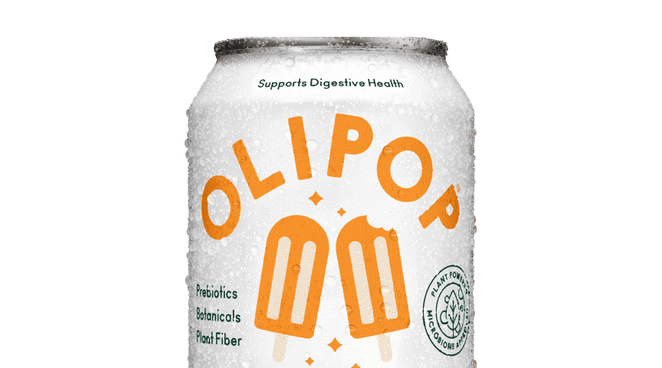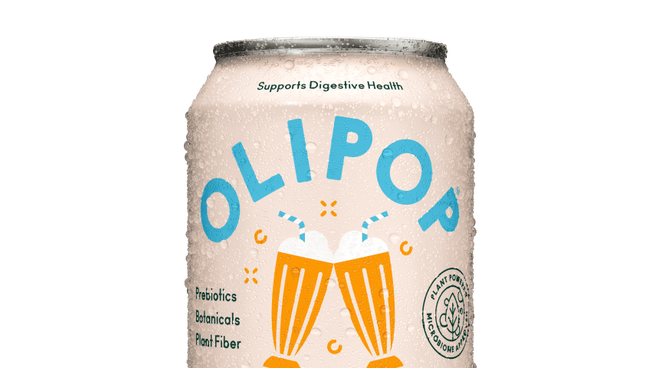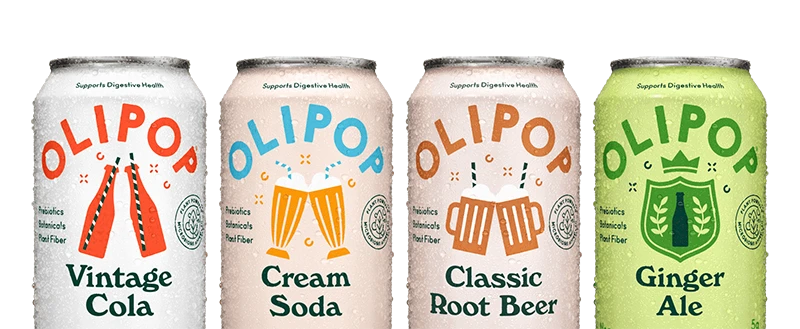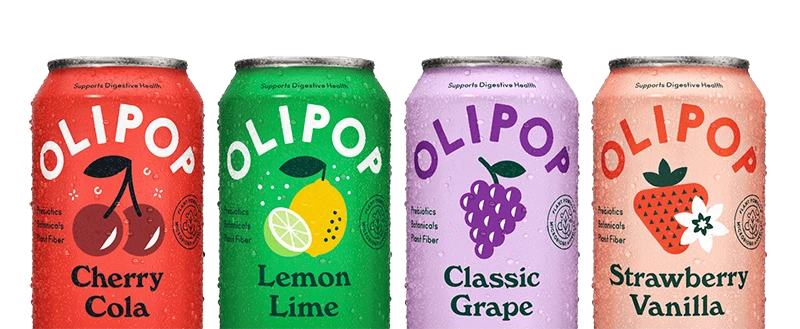Editor's Note: This article is reviewed by Lauren Manaker MS, RDN, LD, a registered dietitian and a paid contributor to OLIPOP. She specializes in digestive health and reviews OLIPOP content for scientific accuracy.
In the quest to satisfy our sweet tooth without the caloric cost of sugar, many of us turn to alternative sweeteners. Among the myriad options available, Stevia and sucralose are popular choices. Both are FDA-approved, calorie-free alternatives to sugar, offering a sweet punch that surpasses that of the traditional granulated variety.
But how do these two contenders stack up when pitted against each other? In this article, we delve deep into the world of Stevia vs. sucralose, comparing their nutritional profiles, safety, uses, and sweetness. Join us as we unpack the complexities of these sweet substitutes and help you make an informed decision in your sugar-free journey.
What Is Stevia?
Stevia is a plant-sourced sweetener derived from the leaves of the Stevia rebaudiana plant, native to South America. For centuries, indigenous populations in Paraguay and Brazil have used Stevia to add a touch of sweetness to their favorite foods and drinks. The sweetness of Stevia comes from a group of compounds called steviol glycosides, found within the leaves of the plant. Boasting an intensely sweet taste, some forms of steviol glycosides are even sweeter than sugar but with minimal calories. This makes Stevia the go-to choice for those looking to reduce their calorie or sugar intake.
What Is Sucralose?
Sucralose is a high-intensity, zero-calorie sugar substitute and is the most widely used artificial sweetener in the United States. Splenda ® is the brand name for this popular artificial sweetener. Unlike other artificial sweeteners, sucralose comes from sucrose (table sugar) through a chemical process that replaces some of its hydroxyl groups with chlorine atoms.1 This gives it less of the aftertaste that often accompanies other sweeteners and more of a sugar-like taste, which is a desirable quality for many people seeking sugar alternatives.2
Sucralose is also over 600 times sweeter than sugar. But unlike sugar, it passes through your system undigested, resulting in zero calories. This makes sucralose a popular sugar substitute. It’s also a favorite in cooking and baking, given that it can withstand high temperatures.2
Stevia vs. Sucralose
Stevia is derived from the Stevia plant, while sucralose is an artificial sweetener created through chemical modification. They both offer sweetness without calories, but they have different taste profiles and are used in various types of products for different purposes. Here’s a little bit more about their differences:
Nutrition
Sucralose and Stevia are both excellent choices for those seeking low-calorie and low-carbohydrate options. Sucralose, a non-metabolized sweetener, has virtually no calories or impact on carbohydrates. Similarly, Stevia is also incredibly low in calories and carbohydrates. Keep in mind that the calorie and carbohydrate content is minimal for both Stevia and sucralose because both are intensely sweet, so you need only a tiny amount to achieve the desired level of sweetness. In other words, the nutrition facts for both are zeros across the board.
Sweetness & Taste
Stevia is intensely sweet, anywhere from 180-400 times sweeter than table sugar. It's worth noting that the sweetness profile of Stevia can be somewhat different from that of sugar, which might lead to subtle differences in taste and flavor. Some people may also experience a slightly bitter or licorice-like aftertaste with certain Stevia products. To counteract this, commercial Stevia sweeteners are often blended with other ingredients or sugar alcohols to enhance their overall taste and sweetness profile.
At OLIPOP, we use Stevia to help sweeten our sodas. But in OLIPOP you won’t notice any bitterness given we also add natural sweeteners like cassava syrup and fruit juice for a more sumptuous and smooth flavor.
Sucralose is also extremely sweet, with over 600 times greater sweetness than table sugar. Unlike some other artificial sweeteners, sucralose is generally known for having a clean and sugar-like taste without a strong aftertaste.
Uses in Foods & Beverages
Stevia sweeteners are available in various forms, including liquid drops, powdered extracts, and granulated forms for cooking and baking. They are used to replace sugar in a wide range of foods and beverages, including coffee, tea, desserts, savory dishes, and soda (like OLIPOP!).
Sucralose, on the other hand, is often used as a tabletop sweetener. It is also heat-stable, making it suitable for cooking and baking. This means you’ll find sucralose in a wide range of products from baked goods to dairy products to candy. There’s also a good chance that your diet soda is sweetened with sucralose.
Stevia vs. Sucralose: Side Effects
So we’ve learned a little bit more about their differences when it comes to nutrition, taste, and uses. But are Stevia and sucralose safe to consume? Well, there’s a bit of controversy around that question. Let’s dive in:
Is Stevia Safe?
Rest assured, Stevia is deemed safe for consumption as long as you use it within recommended limits. Stevia extracts, specifically the steviol glycosides they contain, have been approved for use as a sweetener by various regulatory agencies around the world, including the Food and Drug Administration (FDA) in the United States and the European Food Safety Authority (EFSA) in Europe.
Numerous scientific studies have also evaluated the safety of steviol glycosides, the compounds responsible for the sweet taste in Stevia, with the conclusion that they are safe for consumption. But as with any food product, it's essential to be mindful of your body's reactions and preferences, especially when trying it for the first time.
Is Sucralose Safe?
Sucralose is one of six FDA-approved sweeteners for food additives.3 The FDA reviewed over 100 safety studies before approving sucralose as an artificial sweetener in 1998. But of those studies, none involved humans, none were published publicly, and only a handful lasted longer than a year.1 This has led to general questions about its safety, prompting health experts to advise caution when it comes to sucralose and other artificial sweeteners. And here’s why:
- Potential weight gain: New research reveals that artificial sweeteners may not be as helpful for weight loss or reducing unhealthy food consumption as we once thought. In fact, they might have the opposite effect, actually making us crave the very things they're meant to replace.4 5
- Negative health impacts: A new scientific review reveals a concerning potential connection between non-sugar sweeteners and type 2 diabetes, heart diseases, and overall mortality.6 This prompted the World Health Organization to release a new guideline in May 2023 advising consumers to skip non-sugar sweeteners for weight loss.7
- Microbiome disruption: Artificial sweeteners like sucralose could impact your gut bacteria and contribute to glucose intolerance, potentially increasing the risk of obesity and other metabolic health issues. In one study conducted on mice, for example, researchers found that sucralose consumption altered gut microbiome composition, which disrupted the development of inflammation and other physiological functions in the body.8 Another study in Glasgow, UK measured the impact of artificial sweeteners and other common food additives on gut microbiome composition. The study found that six of the additives, including sucralose, influenced the microbiome and affected the production of short-chain fatty acids, which are nutrients your body needs to stay healthy.9 10
- Impacts on your metabolism: Sucralose, and other artificial sweeteners, are seemingly non-nutritive, meaning they don’t metabolize in the body and therefore can’t contribute calories. However, a 2018 study found that sucralose does indeed metabolize and bioaccumulate in rats. This is prompting questions about exactly how much we know about sucralose and other artificial sweeteners, and clearly more data is needed to have a clear understanding about what happens in the body when this product is consumed.11
So, is sucralose safe? The short answer is that we don’t know yet. Like most other food items, the quantity of the item consumed needs to be considered before deeming it “safe” or “unsafe.” A once-in-a-while treat made with sucralose is likely safe to consume. Consuming large quantities of this sweet stuff every single day? More research is needed to know.
We need more research to dive into the long-term effects of artificial sweeteners. So although sucralose and other non-nutritive sweeteners can help you cut back on sugar, it's recommended to consume in moderation and be mindful of the potential impacts it could have on your body. You can learn more about these and other potential side effects of artificial sweeteners in our blog, Health Facts on Sugary Soda: The Truth about Artificial Sweeteners.
Stevia vs. Sucralose: The Takeaway
Sucralose is the most popular artificial sweetener in the United States, taking its place on the ingredients list of over 6,000 products.1 But more and more research is coming out suggesting some potentially troubling insight into the potential health risks of sucralose and other artificial sweeteners, especially if large quantities are routinely consumed.
Artificial sweeteners like sucralose are man-made or chemically modified in a lab. At OLIPOP, we use Stevia, a plant-sourced sweetener alternative that comes from the Stevia rebaudiana plant. At OLIPOP, we take health (especially the health of your gut microbiome!) super seriously. That’s why we’ve assembled a global team of leading human gut microbiome research pioneers to craft a soda focused on supporting your gut health. With their guidance, our soda combines only the best ingredients, including natural sugars from fruits, cassava syrup, and a high-quality, mild strain of Stevia leaf extract for maximum enjoyment. Sounds like a delicious option to us!
Sources
- Malkan, S. (2023, July 25). Sucralose: Emerging science reveals health risks. U.S. Right to Know. https://usrtk.org/sweeteners/sucralose-emerging-science-reveals-health-risks/
- Mikstas, C. (2023, July 12). What to know about Sucralose. WebMD. https://www.webmd.com/diet/what-to-know-about-sucralose
- How Sweet It Is: All About Sweeteners. (2023, June 9). U.S. Food and Drug Administration. https://www.fda.gov/consumers/consumer-updates/how-sweet-it-all-about-sweeteners
- Hari, V. (2020). Feeding you lies: How to Unravel the Food Industry’s Playbook and Reclaim Your Health. Hay House, Inc.
- Is sucralose (Splenda) bad for you? (2021, January 12). Cleveland Clinic. https://health.clevelandclinic.org/is-sucralose-splenda-bad-for-you/
- Health effects of the use of non-sugar sweeteners: a systematic review and meta-analysis. (2022). World Health Organization.
- WHO advises not to use non-sugar sweeteners for weight control in newly released guideline. (2023, May 15). World Health Organization. https://www.who.int/news/item/15-05-2023-who-advises-not-to-use-non-sugar-sweeteners-for-weight-control-in-newly-released-guideline
- Bian, X., Chi, L., Gao, B., Tu, P., Ru, H., & Lu, K. (2017). Gut microbiome response to sucralose and its potential role in inducing liver inflammation in mice. Frontiers in Physiology, 8. https://doi.org/10.3389/fphys.2017.00487
- Gerasimidis, K., Bryden, K., Chen, X., Papachristou, E., Verney, A., Roig, M., Hansen, R., Nichols, B., Papadopoulou, R., & Parrett, A. (2019). The impact of food additives, artificial sweeteners and domestic hygiene products on the human gut microbiome and its fibre fermentation capacity. European Journal of Nutrition, 59(7), 3213–3230. https://doi.org/10.1007/s00394-019-02161-8
- The microbiome. (2022, July 25). The Nutrition Source. https://www.hsph.harvard.edu/nutritionsource/microbiome/
- Bornemann, V., Werness, S. C., Buslinger, L., & Schiffman, S. S. (2018). Intestinal Metabolism and Bioaccumulation of Sucralose In Adipose Tissue In The Rat. Journal of Toxicology and Environmental Health, 81(18), 913–923. https://doi.org/10.1080/15287394.2018.1502560
- Stevia is a plant-sourced sweetener derived from the leaves of the Stevia rebaudiana plant and is anywhere from 180-400 times sweeter than table sugar.
- Sucralose is the most widely used artificial sweetener in the United States. Unlike other artificial sweeteners, sucralose comes from sucrose (table sugar) through a chemical process that makes it more than 600 times sweeter than sugar.
- Although sucralose and other non-nutritive sweeteners can help you cut back on sugar, it's recommended to consume in moderation and be mindful given potential negative health impacts.




